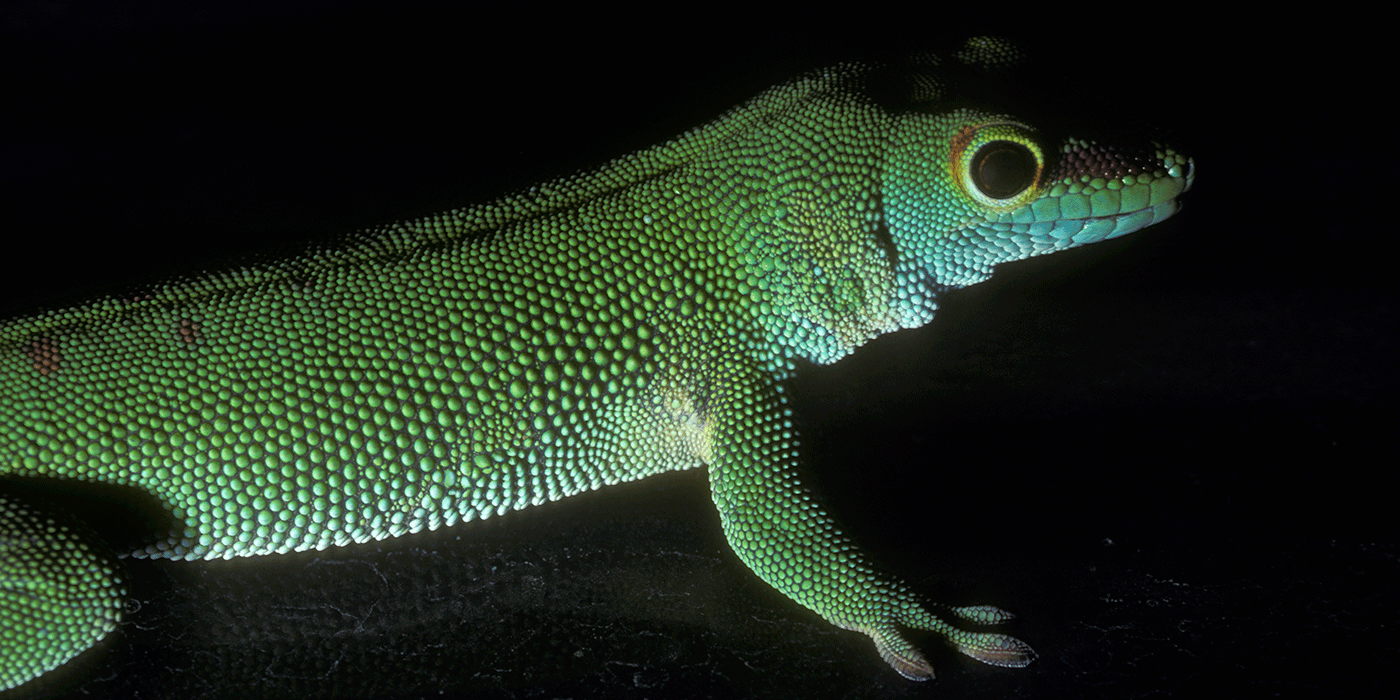Physical Description
Madagascar giant day geckos are bright green, which helps them camouflage among tropical leaves as they wait for prey. They have some red mottling along the body, red spots on the back and a deep red line from the eyes to the tip of the snout. Males have distinctly broader heads and are generally more colorful than females. Young geckos have a yellowish-green head but are brown about the neck and body.
Day geckos do not have claws, but their toes have thin, broad, adhesive scales (called lemellae), which allow them to climb smooth surfaces. Their eyes are large, with round pupils ringed in bright blue. Their tails are as long (or longer) than their bodies.
Size
Adults can grow up to 10 inches (25 centimeters) long.
Native Habitat
Giant day geckos are native to eastern Madagascar, but populations have been introduced to oceanic islands surrounding Madagascar, as well as to Hawaii and the Florida Keys. These lizards were likely first brought in as pets. Day geckos are generalists when it comes to habitat choice and prey, which enables them to thrive in a range of habitats in the environments they have been introduced to. They primarily live in the canopy trees of tropical rain forests and in palms of coconut plantations.
Lifespan
Madagascar giant day geckos can live up to 15 years in zoos.
Communication
Geckos are the only lizards that can produce more than a hiss or other simple sound. Their vocalizations range from squeaks and clicks to barks and croaks. The name gecko is likely derived from one of this lizard's calls, which is produced by clicking its broad tongue against the roof of its mouth. The vocalization resembles the sound of an injured frog.
Food/Eating Habits
Giant day geckos mainly feed on arthropods (crabs, insects, spiders and scorpions) but will occasionally eat sweet fruits and like to lick honey. They get water from condensation that forms on leaves.
At the Smithsonian's National Zoo, they eat crickets twice a week.
Sleep Habits
Day geckos are diurnal, meaning they are most active during the day. They tend to rest and sunbathe on relatively smooth surfaces.
Social Structure
Day geckos can be quarrelsome among one another.
Reproduction and Development
Sexually mature males develop enlarged pores on their hind legs and produce a waxy substance resembling droplets. Sexually mature females may have calcium deposits on each side of the neck.
Females generally lay two eggs several times a year. The female then holds the eggs with her hind legs for a few hours until they become hard. The eggs require incubation from 47 to 82 days. The young reach sexual maturity in one year.
Conservation Efforts
While these geckos do not face significant threats, they are a popular exotic pet and can pose a threat to other gecko species when they are introduced to foreign environments. Madagascar giant day geckos have been introduced to the islands surrounding Madagascar, such as Seychelles, Réunion, Mauritius and Comoros, where they put endemic gecko species at risk. The day geckos native to these islands are more likely to be specialists, preferring more specific food items and habitats than the giant day geckos. The introduced geckos create more competition for resources. The increased stress can lead to poor reproductive success and, over time, a reduced population.
A study on the impact of Madagascar giant day geckos in Mauritius revealed fewer endemic (or native) day gecko species where the Madagascar giant day gecko was present. Anecdotal reports from local residents in Mauritius suggest it took less than 12 years for Madagascar giant day geckos to impact endemic species, and endemic day geckos were completely eradicated from one small town. A similar pattern likely exists in the other oceanic islands where Madagascar giant day geckos have been introduced.
Help this Species
Choose your pets wisely, and do your research before bringing an animal home. Exotic animals don’t always make great pets. Many require special care and live for a long time. Tropical reptiles and small mammals are often traded internationally and may be victims of the illegal pet trade. Never release animals that have been kept as pets into the wild.
Share the story of this animal with others. Simply raising awareness about this species can contribute to its overall protection.
Smithsonian's National Zoo and Conservation Biology Institute. (n.d.). Madagascar giant day gecko. Retrieved January 7, 2026, from https://nationalzoo.si.edu/animals/madagascar-giant-day-gecko
Animal News





